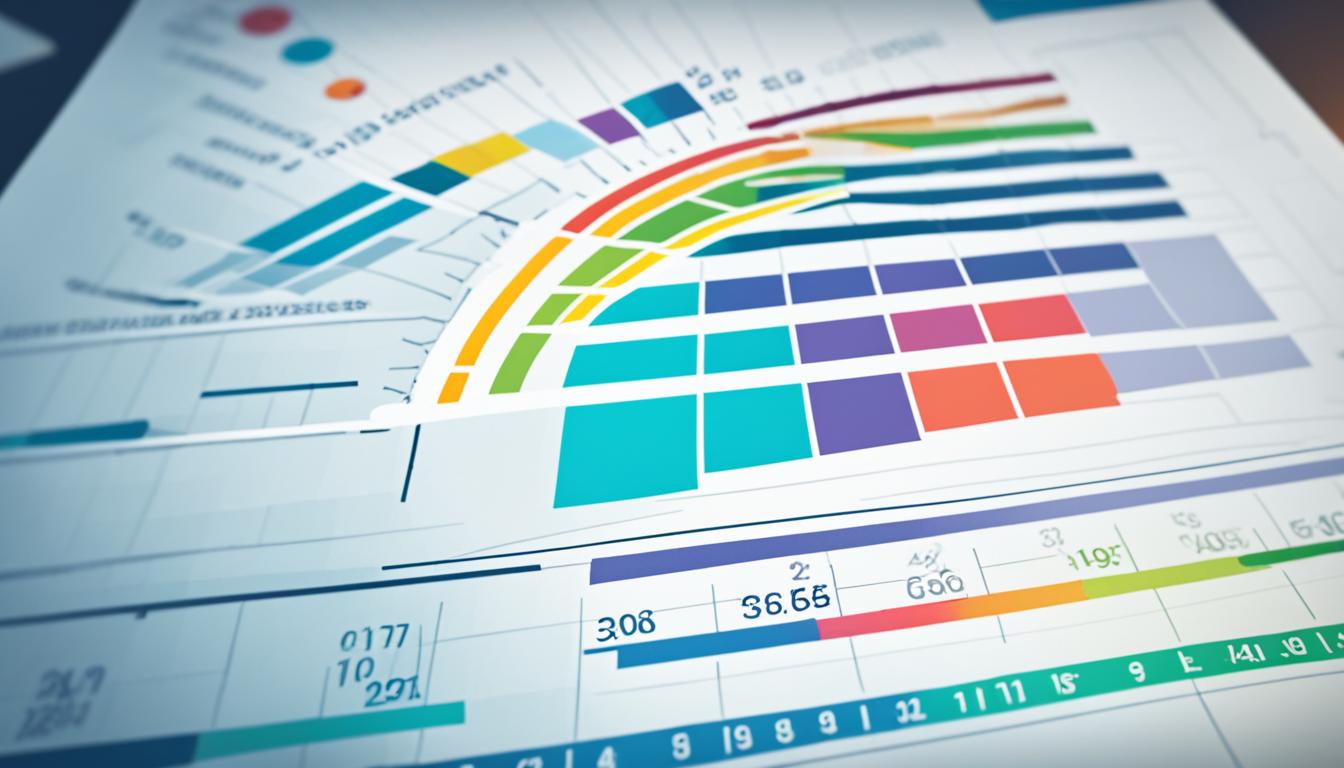The brand development index (BDI) is very important for marketers. It helps them see how well their brand is doing in certain market areas. The BDI looks at a company’s sales compared to the number of people in a market. This helps brands figure out where they stand.
By using a special formula to find the BDI, companies can better understand their reach. They can also decide where to use their resources best. Let’s dive into what BDI means in marketing and why it’s key for growing a business.
Key Takeaways:
- BDI measures a brand’s performance in relation to the population of a particular market.
- It helps brands tailor their marketing and advertising techniques to target specific customer segments.
- Calculating BDI involves comparing a brand’s sales to the total market sales and population.
- Implementing BDI in marketing planning allows brands to optimize their strategies and allocate resources effectively.
- BDI provides valuable insights into a brand’s market potential, target audience, and areas for improvement.
Why is a brand development index important?
The brand development index (BDI) is key for mapping out marketing plans. It helps businesses pinpoint the best spots for ads. Knowing about BDI helps companies stretch their ad budgets further.
BDI sheds light on sales versus the number of people in a place. This info lets companies get to know their buyers better. Then, they can make ads that speak directly to them.
BDI guides where to spend money on marketing. Companies can put more into areas with big growth chances. This smart spending means better results and more interest from customers.
BDI shapes how companies grow or keep their spot in the market. A high BDI points to a need for more ads to grow. But a low BDI means focusing on keeping current customers.
Using BDI well changes how companies approach their ads. It helps them find the right people to talk to. And it fine-tunes their messages for better brand growth.
How to Calculate a Brand Development Index
To calculate the Brand Development Index (BDI), compare a brand’s sales to the market’s population. You need to use a formula that gives a whole number. The BDI shows how well a brand does in a certain market area compared to the overall market.
The BDI calculation offers insights for audience division, targeting, and positioning in marketing plans. By knowing a brand’s performance in a specific market, companies can make their marketing better. This improves the brand’s reach and potential in the market.
BDI Calculation Formula
With the BDI formula, businesses can figure out their brand’s performance and market success. The BDI helps measure how effective marketing strategies are. It also guides where to put resources for the biggest impact.
Example of a Brand Development Index
Using BDI in marketing planning means thoroughly analyzing a brand’s market performance. Let’s take Samsung laptops in a city as an example to understand BDI better.
We’ll compare Samsung laptop sales in City X with total laptop sales nationwide. We’ll also look at City X’s population versus the country’s total population.
First, let’s gather the necessary data:
| City X Sales | Total Country Sales | City X Population | Total Country Population | |
|---|---|---|---|---|
| Samsung Laptops | 500 | 5000 | 100,000 | 1,000,000 |
To calculate the BDI, we divide the City X Samsung laptop sales (500) by the total country sales (5000). Then, we multiply by 100 to get a percentage. Here’s the formula:
BDI = (City X Sales / Total Country Sales) x 100
So, the BDI for Samsung laptops in City X is:
BDI = (500 / 5000) x 100 = 10
A BDI of 10 means Samsung’s performance in City X is low compared to the overall market. This info helps in planning marketing efforts and allocating resources better. It points out where the brand needs to boost its market share and presence.
BDI analysis gives companies insights into how well their brand is doing in specific markets. By looking at BDI scores in various places, brands can customize their marketing efforts. They can also distribute resources wisely to grow successfully.
What is a Brand Development Index?
The Brand Development Index (BDI) is important for knowing how well a brand does in a certain market. It looks at the brand’s sales in a market compared to the market’s population. This tells us how the brand is performing.
If a brand’s BDI is 100, it means it matches the market. It’s doing as expected. A score above 100 means the brand is doing better than usual in that area. But, a score below 100 shows it’s not doing as well.
The BDI helps marketers see how their brand competes in different places. It tells them where their brand is strong and where it can grow. With this info, they can better plan their marketing and find the best markets for their products.
Why the Brand Development Index Matters
The Brand Development Index (BDI) is key in shaping marketing strategies and gauging ad success. It gives businesses insights into their brand’s market performance. This helps them plan their branding, product development, and placement wisely.
By looking at their BDI, companies can see how well their strategies work. They learn how their brand connects with their target customers. This is vital for effective marketing and product or retail strategy refinement.
The BDI’s impact on marketing is important for enhancing brand success and tapping into the market’s full potential. It shows where a brand might be falling short. Businesses can then act to boost their performance.
Beyond Sales Numbers
The BDI offers a deep dive into how a brand truly fares, beyond just sales. It considers market demographics, population size, and buying habits. This shows a brand’s true reach and potential in specific markets.
For companies looking to grow, the BDI points the way to promising markets. It aids in smart resource distribution and refining marketing to hit the right audience.
It also aids in making informed product development decisions. The BDI highlights market opportunities and consumer likes. This helps companies tailor their products to meet consumer demands.
The Role of BDI in Advertising
The BDI is crucial for crafting ads that hit home. It clarifies how understanding BDI shapes marketing strategies. This leads to ads that truly speak to the target audience.
Through BDI analysis, firms can pinpoint where to advertise for the best return. They can direct their ad spend to high BDI markets for better results and revenue growth.
The Brand Development Index is vital for marketers navigating the competitive field. It aids in making clever choices and enhancing brand success. Leveraging BDI insights helps companies secure their spot in the marketplace.
Purpose and Utility of BDI for Brands
BDI, or Brand Development Index, is vital for creating marketing plans and growing brands. It measures a brand’s success in particular markets. This lets brands see their market potential and discover growth opportunities. See how BDI is crucial for brands:
- Measuring Brand Success: BDI gives an accurate picture of a brand’s market segment performance. It shows how a brand stacks up against the entire market.
- Matching Brand and Market Potential: BDI checks if brands are meeting their market potential. It compares sales to the market’s population, highlighting over or underperformance.
- Finding Market Chances: BDI reveals where a brand does well or poorly against its market share. This helps target marketing to the most promising segments.
- Improving Marketing Plans: BDI sheds light on marketing adjustments. It informs how to distribute resources, customize messages, and target effectively for better outcomes.
Top Ten Components of BDI
The Brand Development Index (BDI) has many parts that play a key role in a brand’s success. Knowing these parts is crucial for analyzing BDI data and making marketing better. Let’s look at the top ten parts:
- Brand Awareness: This shows how well a target group knows a brand and what it offers.
- Market Positioning: It’s about seeing where a brand stands against its competitors and target audience for its BDI.
- Customer Perception: It’s important to get how customers see a brand and its image to match marketing plans.
- Brand Loyalty: How loyal customers are and if they keep buying from the brand significantly affects BDI.
- Competitive Analysis: Looking at the market’s landscape, including where competitors stand, helps understand BDI better.
- Market Dynamics: Keeping an eye on trends, demands, and shifts in the target market helps figure out a brand’s BDI and tweak marketing plans.
- Marketing Effectiveness: Finding out how well marketing efforts are working is key for BDI analysis and improvement.
- Product Differentiation: How unique and different a brand’s products or services are adds to its BDI.
- Customer Segmentation: Dividing the target audience based on certain characteristics helps with BDI analysis and targeting.
- Digital Presence and Online Engagement: How well a brand does online, including social media activity, website visits, and online reviews, affects its BDI.
Together, these parts offer a full picture for measuring a brand’s success and making marketing better based on BDI. By looking at each part and choosing based on data, companies can boost their marketing efforts and push brand growth.
Conclusion
The Brand Development Index (BDI) is a strong tool for analyzing a brand’s performance. It helps businesses make smart marketing choices. By learning to calculate and understand BDI, brands can discover their market reach and preferred audience.
Using BDI in marketing planning lets brands use their resources wisely and boost their marketing actions. With BDI, businesses can spot market chances, better their brand’s position, and encourage brand growth.
BDI is more than a simple metric. It’s a strategy for brands to make choices based on data. By adding BDI to their marketing plans, brands can match their strategies with their audience, increase their investments’ value, and meet their goals.





